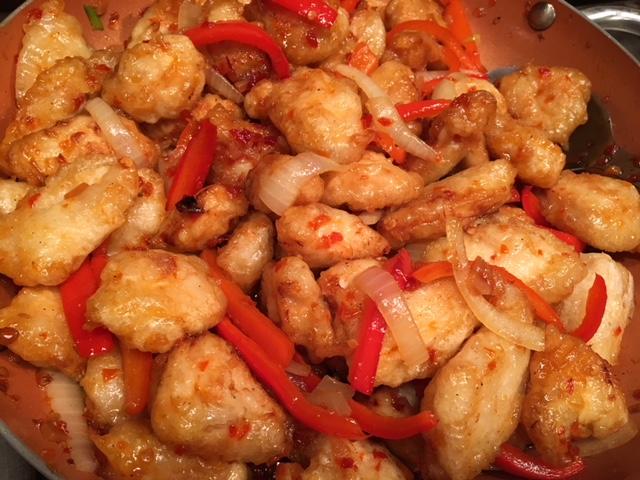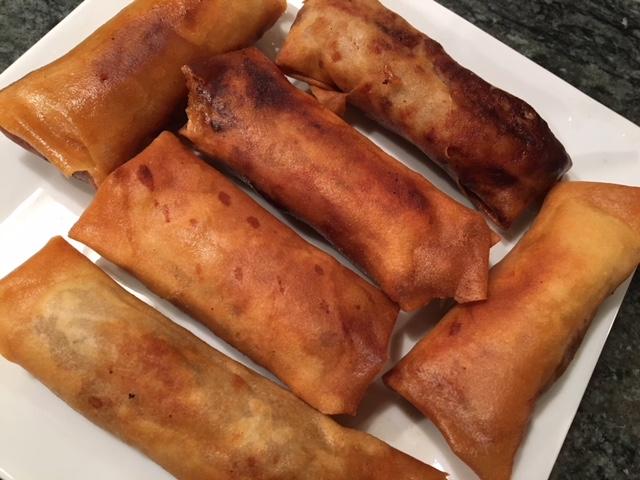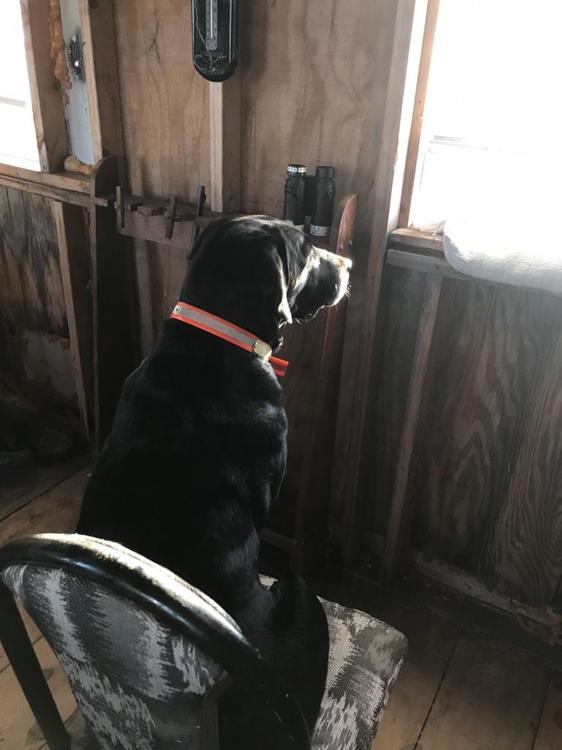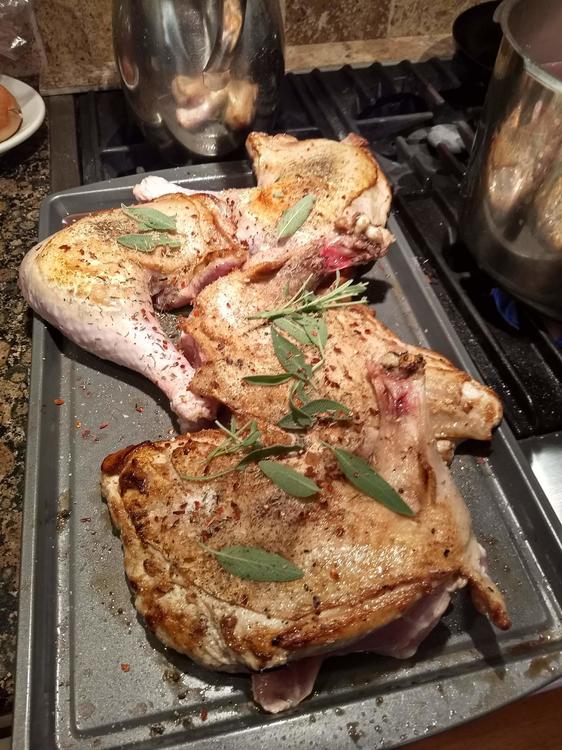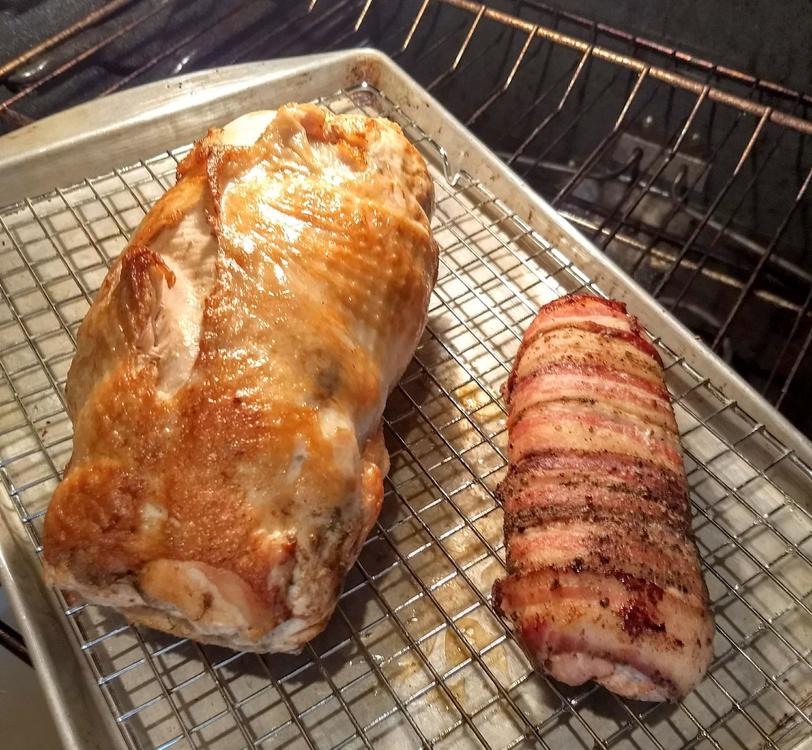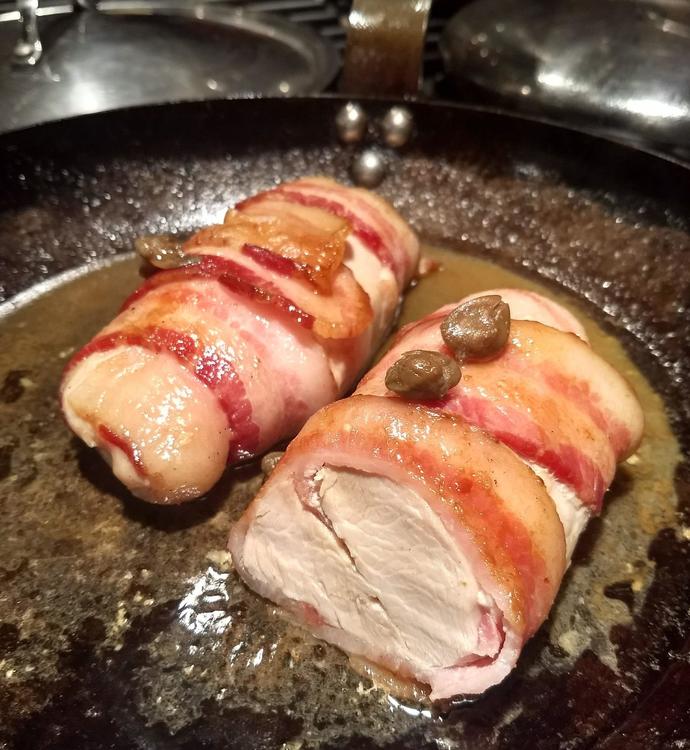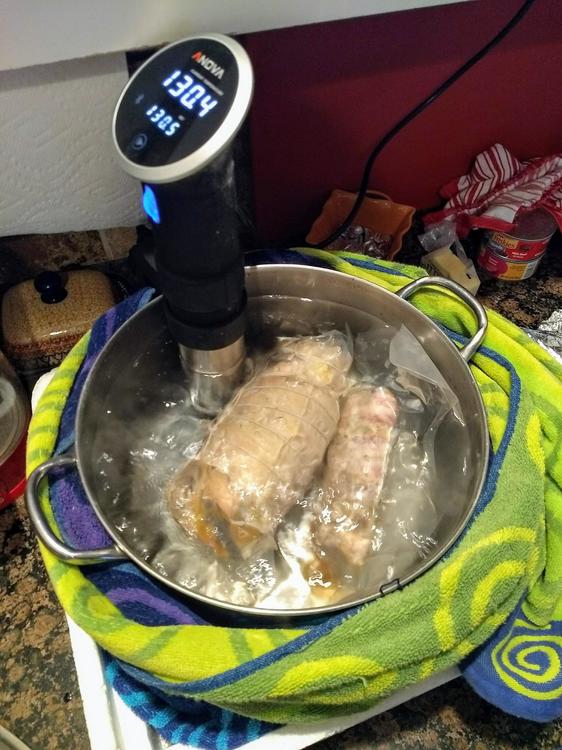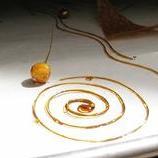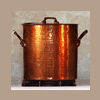Search the Community
Showing results for 'wok'.
Found 5,140 results
-
So, next I cut up a whole bunch of red bell peppers and onions and grated the ginger for the Honey Chicken. Then I moved on and cut up more onions and broccoli for the lo mein. I had some green beans that I had done in the Instant Pot left over from the tart the other day so I thought those would go good in there, too. Lo mein is super easy. Get a pint jar with a lid and put in 3T. of soy sauce, 1 t. sesame oil and 1t. sugar. Shake it up. Boil your water and cook your noodles --I use this brand Heat a bit of oil in a skillet or wok and sauté what ever veggies you think sound good--I did onions and broccoli--didn't have to do the beans as they were already soft enough. When the veggie are done to your liking add a shot of mirin and give it all a stir then add the drained noodles and your sauce. I put the pork belly in the instant pot along with the whole can of broth. 30 minutes, high pressure, natural release. Heavenly. And, we have a whole bunch of really wonderful broth to use later. Then, I used the other instant pot to make the rice. Then I tossed the chicken into the honey sauce. Then I fried the egg rolls. Then I had like 20 glasses of wine. Kidding. Maybe. Here is everything finished Honey Chicken Pork Belly Lo mein Eggrolls Our hunter's plate And this is happening as we speak---Chum is in her lookout chair in the shootin' house.
-
Tender and tasty, indeed! But, if it's time and temperature, it was 24 hours at 125 F. Then I reduced the cooking liquids in a screaming hot wok, added a bit of peanut oil and browned it on all sides and put in the fridge to cool. HC
-
I've tried a couple of turkey recipes this week. The first bird got the treatment as outlined in Chefsteps procedure for crispy, confit turkey legs and breast. The parts get a pre-sear followed by sous vide of the leg/thigh for 12 hours at 149 F then add the breast with another 12 hours at 131 F. A final sear and it was ready for the plate. I'll probably repeat this for Thanksgiving dinner. The meat was moist with a nice texture and will make a nice presentation. Here's a picture of the pre-seared and seasoned turkey prior to the hot water bath. Last night I prepped a 16# turkey with the breast and tenderloins prepared for sous vide and the remainder into the pressure cooker for stock and meals for our dog. The breast were prepared following Serious Eats Turchetta recipe and the tenderloins were bacon wrapped. I used transglutaminase to bond the skin and meat in both items. I cooked the tenderloins for 4 hours at 130 F and the Turchetta for a total of ~14 hours. I finished both items with a quick fry in the wok. The taste and texture were great for each. This is an earlier photo using chicken breast and finishing the dish by browning in a skillet. And here's a photo my set-up. I use an Anova cooker in a 12 qt. pot. To minimize heat loss I set the pot on an old Styrofoam cooler lid with blanket around it. I top it with a piece of foil and it will go for 24 hours without adding any water. For larger items I use a conventional cooler that I set-up in the garage.
-
Just a tip on searing. I've taken to using a carbon steel wok on top of my highest gas heat. The very thin steel conducts the heat better than any fry pan I've used and gives a great sear. I simply lightly coat the meat in a high-temperature smoking oil such as grape seed and put it in the pre-heated wok until the desired sear is achieved.
-
Guoba (锅巴) "Traditionally guoba forms during the boiling of rice over direct heat from a flame. This results in the formation of a crust of scorched rice on the bottom of the wok or cooking vessel. This scorched rice has a firm and crunchy texture with a slight toasted flavour" - Wikipedia
-
I've been looking around the web and it appears that the AirFryer is like extreme convection cooking, whereas the Actifry is more like an automatic stir-fryer. I think the Actifry could work well enough on small items (e.g. fries, although I'd be sorely tempted to put it up against a wok), but not so much on larger items, say, a chicken leg (unless you like yours prepared by tiny hockey players). I don't think either would stand up to the results of true deep frying. Walmart has a (Air Fryer-Type) version from another manufacturer for $99.99, but the reviews vary widely (5 stars, or broke before completing a single cooking cycle). In fact, I can't find a single review for the AirFryer from someone who either isn't wearing a Phillips apron, or is not reading off the box or the enclosed recipe book.
-
I don't own one of these, but I have been reading along here. It seems that this device is best suited to heating frozen fried foods, as they have a considerable amount of fat coating them already. -And coating them really evenly. I think it's going to be difficult to take vegetables from scratch and get them to rival real fried foods. It may be useful for quickly cooking other random foods, like that braised meat, but I am not really feeling it. I think I'd rather pan fry in a cast iron skillet or my wok.
-
We tried making shrimp chips in the fryer. Brilliant. We brushed the chips with a little oil and put them in the fryer at 390F for just a couple of minutes and they were cooked. The only problem is they curl up rather than being flatter like when you make them in a wok with tongs. Virtually no fat on them. Will be making these again. sorry no picture.
-
I do it with a dry cure following the proportions in Julia Child's recipe from The Way to Cook. Add several cloves of garlic for Jewish style corned beef. I've done it both with and without pink salt. I usually cure at least two weeks, but if it let it stay for four weeks, it will keep for months, which I've done, and it doesn't change much after four weeks. If I know that I'm not planning to cook it for a long time (usually because I've bought a large amount of beef as part of a cooperative beef purchase, and making a corned beef saves some freezer space), I tend to use the pink salt. If you do let it cure more than four weeks, you need to let it soak overnight or even for two days to de-salt it. Then I usually simmer it until a fork slides in and out of the meat easily, but recently I made a pastrami by coating it with pepper and coriander and hot smoking it on the stovetop in a wok, and it was excellent. It took about three hours smoking with no additional cooking. Brisket is a cut that shrinks a lot. I wouldn't bother with a brisket smaller than 4-5 lbs. That's usually the whole flat end or the "first cut" as it's sometimes called. The second cut is much fattier, but pastrami made from the second cut fries up nicely like bacon.
-
One of the great pleasures of making one's own corned beef is the fantastic aroma when opening the bag it's been sealed in before cooking it. After doing this myself for several years I noticed a Freirich corned beef on sale at the supermarket after St. Patrick's Day, and thought, "what the heck, I'll dredge it in pepper, garlic, and coriander and smoke it in the wok, and make a pastrami" as I've occasionally done with my own corned beef, and it is presently smoking on the stovetop, but there was no particular pleasure in opening the bag. It had the aroma of nothing in particular--old wet meat. It will be okay, I'm sure, but I think that's my last store-bought corned beef.
-
A great pan sauce can be made for pork by deglazing the pan after sauteing chops with bourbon, adding shallot, dijon mustard, honey, a little stock and heavy cream. Also for Jaybee's honey and grapefruit, I had an excellent salad once of wok seared diver scallops served over chicory and radicchio with section of grapefruit in a warm honey balsamic vinagrette. My favorites are Tupelo, Orange Blossom, and a local honey made in the southend of Louisville where the bees are on tulip poplars and the honey comes out almost as dark as sorghum.
-
HomeEc. cooking stations!! How I disliked giving classes in them! No control! It's hard to be everywhere at once. Teen-agers listened to directions, but adults went their own way. I would explain and do a dish from scratch so that all all could see the preparation and procedure ---- then the groups went to their 'station' to do it themselves. I could hear the comments: "Just toss it all in at once - that's the way I do it at home." / "She said NOT to burn the garlic!" / "I just cut it all up, any old way --- it all tastes the same." ARRGGHHHHH! The interests have changed over the years. At one time people wanted to do Beggar's Chicken, or Tea Smoked Duck or some other dish that required special preparation. But now they want instant food. I do Basic Wok/Stir Fry classes, and Basic Dim Sum every once in a while, but for the most part I try to follow a theme. Just Chinese soups, or fish, or a region, just sauces, interesting vegetables beyond broccoli, noodles, all steamed dishes, a lunch menu, casserole/sandy pots ---- whatever catches my fancy. Some is total hands-on, some is partial hands on. I can do pretty much whatever I want. No more than 8 people and all Chinese cooking. I've given up the demos at different organizations, and catering. Now it is just Spring and Fall classes for an adult school. I use my gas stove for things as they cook, but I use my butane stoves at a special round table for the actual cooking -- like stir/fries or deep/fries etc. Without those stoves, I would be lost. I used to have a small propane stove with a quart tank and a loooooong hose. It was very impractical. The tank itself would freeze up, and the whole thing scared me. When the good butane ones came out, it was a God-send! There are different kinds. If you decide to get one, let me know so I can give you some tips.
-
LOL! (Bunsen!) For really great heat from a portable stove, you need propane, but they can be a problem in a closed area because of the gas. There are portable units that can be connected to the natural gas line. Then there are induction woks. Very high heat (BTU - 45,000) --- VERY expensive. The patio wok units use propane, too. They are portable and expensive. Viking has some units, but I believe they are propane or can be connected to the gas lines. For plain old butane, you won't get the BTUs of propane, but you can get some almost as hot or maybe hotter than your gas stove. Regular stoves range from 7000 BTUs to 14,000 BTUs. That may all have changed since I last looked into it. I have four different butane stoves, but the best one, by far, is one by "Iwatani". They make a couple of models, but my favorite is the "The Cassette-Feu 30-FW ". (This is not the same Cassette au Feu that is often advertized,, and was one of the first butane stoves to appear on the market. I have one of those, and the heat output is very low.) The Cassette-Feu 30-FW has a unique feature that is worth the $60-$70 I paid for it: Normally when a butane can reaches the end of the gas, the flame slowly goes down and stays at a low level for awhile before it finally dies out. Very ineffective for wok cooking. Not the 30-FW. It keeps the high flame until it is just about out of gas. The flame goes down quickly and then goes off. Also, the can stays in place by a magnet -- not an outside lever that can pop up. This model has a BTU of 12,000. Not the same as a restaurant range, but with an adjusted stir/frying technique, you can do a good job. Their other model is less expensive, and has a BTU of 10,000. Maybe others have other experiences or ideas?
-
WHEW!!!!!! You deserve a rest!!! Sounds like you were well organized --- which is the key. And------the order in which you served, seemed to answer Loufood's suggested soft rules. Did you serve anything in the steamers, themselves? Do you have one of those butane stoves that you can put on the counter? I have several that I use both in my cooking classes, and when I am doing alot of cooking on my own. It frees up stove burners ---and especially good for some large bulky things like steamers. An electric wok is also good for this. I've never done the hot oil as was suggested, (except over steamed fish) but I sure will next time I do vegetables, and will make sure everyone hears the 'sizzle'. LOL! It's amazing how a simple vegetable dish can be so welcomed when you are having all those doughy things. Thank goodness for microwaves!! That tea sounds like Te Guan Yin, or Ti Kuan Yin (pick your transliteration) one of my favorites. Tell me --- did you eat anything yourself?? I have a hard time eating when I undertake a big meal like yours --- but if there is anything left over, the next day, I pig out! Your guests must have been impressed. You should take a bow and sit back with a cup of that tea -------after the @#$%$# clean-up, of course! Thanks for coming back and letting us all enjoy!
-
They're available in San Francisco. Other shops (Gin Wall?) may be cheaper, but the Wok Shop has them available online. The WS also has the Chinese "moon cookie" molds. The cookie molds look like this: Wok Shop Website
-
I'm sure NYC had to have black pepper sauce and mayonnaise shrimp before 1997. When we had our Chinese restaurant in Philly, we got our chef from NYC. And that was back in 1991. That's when I started eating stuff like that. How long before 1997 did the chefs start to leave HK? I would guess it would be long before and because of the changeover. A couple of HK banks opened up early in the 90s in NYC's Chinatown, but they fizzled out. Do you have any idea how the Black Pepper dishes started? Not as the black pepper in H&S soup and Northern dishes, but as in sauces over sizzling platters, and over beef fillets? Actually, I think I misunderstood your previous statement. I thought you were saying you started seeing black pepper sauce and mayonnaise scallops in NYC in 1997. Anyway, I do understand how black pepper filet is cooked. Actually, it's even better if you can find a good butcher with short ribs. Short ribs in black pepper sauce isn't available anymore in Philly Chinatown, but there's this old Jewish butcher we used to use for short ribs. I liked and still do like short ribs in black pepper sauce better than the filets. Too bad it's not available. The filets aren't bad, mind you. Very tender and they carry the sauce pretty well. Just better with the short ribs. Traditionally we used to stir fry the short ribs/filets in with sliced onions, sliced green peppers and the black pepper sauce in the wok. (At least I think we had onions. It's been a while since I've had it.) The hot plate is heated on the stove over the burners. When the dish is done, it's scooped out onto the waiting hot plate, which is itself sitting on a wooden board cut to size. It always made a nice loud sizzle as you walked through the dining room. Many customers turned their head and asked what that was. It did inspire many a copycat order. Ah, a trip down memory lane.
-
Sorry, Ah Leung, but I'd have to disagree with you on cook, refridgerate overnight, then re-steam process. From my experience, especially when we ran the Chinese New Year dim sum buffet for +250 people, I found that it is better to make the dim sum, freeze individually, then steam from frozen state just before serving for the best results. With char siu baos made with baking powder dough, I steamed them then froze them, even a week ahead. I'd bring them out the night before the event, thaw in the walk-in cooler over-night, then re-steam just before serving. We had three 28" woks with the biggest bamboo steamers stacked 3 high going for the full duration of the brunch run so there was freshly steamed items filling the buffet table all the time. The grill was for potstickers, using covers from large chafers for the steaming part.
-
I've never tried it, but I'm thinking an asian-style Matzo brei, cooked in a stir fry oil in a wok with lots of chopped scallion, chinese leeks and some mushrooms with a dash of dark soy would be really good.
-

Serious climate- and health-related concerns about gas stoves
EatingBen replied to a topic in Kitchen Consumer
I’ve a high powered gas wok burner outside, want a big charcoal bbq. Inside I’ve unfortunately a plain electric cook top and a portable induction cook top. Moved here from an apartment that was gas and really good gas cook too at that as well. im going to stick with gas outside and when the kitchen gets renovated it will be changed to a high powered induction cook top. For years I fell into the camp of gas but the cheap induction cooktop has converted me it’s a 100 times better then gas has ever been in the 19 or so years I’ve had it. Plus these studies are just confirming everything already known about gas cook tops they aren’t as healthy and combustion if any type shouldn’t be in a closed environment especially in places where we don’t have lots of mechanical ventilation like the USA in Australia we have doors and windows and that’s about it mostly not all kitchen hoods vent outside unfortunately. charing peppers doesn’t work as well with induction though haha -
OK let's get this back on track, so here's a pseudo-recipe for a Lahori-style goat karahi as I'd make it, one of my favorite uses for goat: Par-cook some goat, until just about done. Simmered, sous-vided, whatever. Include onions, tomatoes, garlic, ginger, cumin while it's cooking if you wish. (this could take a few hours) When the goat is nearly done, heat up a wok with a good glug of oil, add minced garlic, ginger, and sliced green chiles. Stir until very fragrant, remove the chiles and reserve them, add some cumin and turmeric, stir, and then add a bunch of fresh diced tomatoes (let's say at least 2 cups' worth). If you want it really hot, add red chile powder. Let that all cook down until the tomatoes have transformed into a thick sauce, periodically adding a splash of water if it threatens to dry out. Once the tomatoes have broken down, add the pre-cooked goat (without all the other stuff it was cooking in) and let it cook until done to your liking. Sprinkle in a spoonful or two of garam masala powder, julienned ginger, and reserved chiles. Top with fresh coriander leaves and serve with naan. (this whole process shouldn't take more than about 20-30 minutes)
-
This was on sale/posted back in 2018. I am posting it again in case someone missed it... Grace Young's "The Breath of a Wok: Unlocking the Spirit of Chinese Wok Cooking Through Recipes and Lore" Kindle Edition $1.99US (eG-friendly Amazon.com link) Use the "Look Inside" feature to see the list of recipes. I am a US Prime member and the price you see may vary.
-
Just ran across this at Slickdeals... Seems of interest to people here: First and last are of particular interest, I think. The Sorcerer's Apprentices: A Season in the Kitchen at Ferran Adrià's elBulli $0.99 The Elements of Cooking: Translating the Chef's Craft for Every Kitchen $0.99 MEAT: Everything You Need to Know $0.99 Food Matters: A Guide to Conscious Eating w/ More Than 75 Recipes $0.99 The Pollan Family Table: The Very Best Recipes and KitchenWisdom for Delicious Family Meals $0.99 The Breath of a Wok: Unlocking the Spirit of Chinese Wok Cooking $0.99 A Homemade Life: Stories and Recipes from My Kitchen Table $0.99 Bobby Flay's Grilling For Life: 75 Healthier Ideas for Big Flavor from the Fire $0.99 The UltraMetabolism Cookbook: 200 DeliciousRecipes that Will Turn on Your Fat-Burning DNA $0.99 My Year in Meals $0.99 The Tucci Table: Cooking With Family and Friends $0.99 Carla's Comfort Foods: Favorite Dishes from Around the World $0.99 Taste: Surprising Stories and Science About Why Food Tastes Good $0.99 Ratio: The Simple Codes Behind the Craft of Everyday Cooking $1.99 Mark Bittman's Kitchen Express $1.99 An Everlasting Meal: Cooking with Economy and Grace$1.99 The Nerdy Nummies Cookbook: Sweet Treats for the Geek in All of Us $1.99 On Food and Cooking: The Science and Lore of the Kitchen $1.99 Thanks megakimcheelove and ProfessorChaos
-
Count me in this camp. I've seen a kitchen fire and would not want to tackle one at home on my own. But your setup looks amazing and I envy much of what you have-- particularly, the wok burner. A friend has one in his kitchen and it makes all the difference. I don't see a broiler or salamander--is it in there somewhere? This setup maybe permissible in Pittsburg, but would never pass inspection here in Boston, much less in a condo (which is what I have). I'm grateful that I'll be able to get 22K BTUs per burner and an infrared broiler in a residential Blue Star when I finally redo my kitchen. Enjoy!
-
Apologies in advance for the length of this tome. Background We bought our house two years ago. The house is well-built, close to work, and we plan to live here for a very long time. When we purchased the house, we knew that we would redo the kitchen and add a bedroom, bathroom, and office. The old kitchen was a walk-through galley, and the kitchen door serves as the main entrance to the house. Opening the kitchen door blocked the main food preparation area. The refrigerator facing the peninsula created an annoying bottleneck. The range was crammed in a corner, so my left-handed spouse could only use two burners. I could go on, but you get the idea. Here is the old kitchen, with the upper cabinets and soffit removed on the right side. Limitations The kitchen is relatively small, and we decided against moving any walls. We were not willing to borrow money for the kitchen renovation. We also had a critical time limitation. My step-son in law is an engineering student and incredibly talented carpenter. He agreed to install cabinets and do finish carpentry during his two-week semester break. The ‘discussions’ Our biggest ‘discussion’ concerned countertop depth. I wanted 30-inch deep countertops for extra prep space. My wife wanted 24-inch deep countertops so she could reach the upper cabinets. Eventually we compromised and installed a mix of 24-inch and 30-inch deep countertops. I can joke about it now (I think). Our list was identical to Dave’s except for the double ovens. Equipment 36-inch, 6-burner Blue Star range top, Vent-A-Hood exhaust, no-frills GE oven, and Whirlpool dishwasher. Cabinets Ikea slab-front birch cabinets in medium brown. Worktops Engineered stone (Cambria) – cost comparable to granite, but harder and less porous. Flooring Hardwood flooring to match the dining room. Q. What was your kitchen before it was a kitchen? A kitchen. Q. How large is the kitchen? 10 feet long x 12 feet wide (3.05 meters x 3.66 meters). The kitchen and dining room are essentially one long room, 21 feet long x 12 feet wide (6.40 meters x 3.66 meters). Q. What kind of cooking do you do? Family? Dinner parties? Ethnic? Gourmet? We cook for a family of four and frequent hordes of visiting children. Occasionally, we host casual dinner parties and holiday meals for groups of 8-12 people. We cook a lot of Asian, Indian, and Mexican food and stir-fry frequently in a wok. Neither of us do much baking. Q. What were the 3 top goals for your new kitchen? 1. Provide efficient work space for three cooks. To eliminate bottlenecks, we removed the peninsula and moved the refrigerator into the corner. To reduce collisions, we added a small prep sink, installed a six-burner range top, and provided space for a future under-cabinet refrigerator (if needed). This enabled us to design three non-overlapping work triangles. 2. Maximize usable counter space. By framing in a useless door, we were able to add three crucial feet of countertop. Installing an out-swinging kitchen door freed another three feet of countertop. 3. Store frequently-used items near their point of use. Q. What was the biggest problem that had to be overcome? In the design phase? During actual construction? In the design phase, the biggest problem was to use the relatively limited space efficiently. The key was to measure the space needed for everything in the old kitchen: flatware; dishes; spices; pots and pans; canned goods; dry goods; small appliances; cookbooks; etc. This information was invaluable during design. During construction, flooring caused the most problems. When we removed the old cabinets, we found asbestos-containing sheet vinyl flooring and water damage beneath the dishwasher. We hired a licensed asbestos abatement contractor to remove the vinyl flooring and sub-floor. To offset this unexpected cost, we eliminated a bow window above the sink. Q. What are you most pleased about in your new kitchen? We are deliriously happy with the Blue Star range top. The 22,000-BTU burners provide enough power to stir-fry effectively, and it is large enough for two cooks to work without interference. With continuous grates, the range top serves as a landing pad for hot items out of the oven. We are strangely delighted with the clean-up area. One side of the kitchen houses (in sequence, left to right): a trash and recycling pull-out; a huge single sink; the dishwasher; flatware drawers; and a tall shallow cabinet for plates and bowls. After meals, we can scrape dirty dishes into the trash, rinse the dishes in the sink, and load the dishwasher without taking a step. Similarly, we can unload the dishwasher and put away most of the dishes without taking a step. Doing dishes is almost a pleasure (and yes, I usually do the dishes). Q. Least pleased about? We have been unhappy with the dishwasher. Our previous Whirlpool was great, but this one has required two service calls in the first nine months. Q. If you were doing your kitchen again what would you change? Not much. We spent a lot of time on the planning stage, and probably looked at every possible layout (and quite a few impossible layouts). We wanted to be sure that we would have no regrets when the kitchen was finished. And to answer my own questions . . . Q: How much of the design did you do yourself? We designed the kitchen using Ikea’s kitchen planning software. My step-son-in-law solved some key design problems, such as where to put the microwave and how to enclose the current refrigerator while retaining the option of a larger refrigerator in the future. Q: How much of the construction did you do yourself? We did all of the demolition, drywall, painting, and scheduling. Our step-son-in-law did the cabinet installation and finish carpentry. We hired electricians, plumbers, flooring installers, and countertop installers Q. How long did the renovation take? How long was it supposed to take? As planned, we were without a functional kitchen for two months. Our schedule was driven by when my step-son-in-law was available to install cabinets. We started demolition early to ensure that everything was ready on time. In retrospect, we could have shortened the schedule a little. Q: By what percentage was the final cost over or under the budget? We exceeded our budget by about 25%, mostly in electrical costs. Complete disclosure: the 25% overrun does not include replacing the main electrical panel because we planned to replace the panel when we added the bedroom, bathroom, and office. Q. Did the relationship between life partners suffer any permanent damage? No, working together on the kitchen probably made our relationship stronger. My wife and I have similar tastes, but we think very differently. Working on a project forces us to hone our communication skills. Here is an overview of the new kitchen: The cooking wall: note bump-out from 24" to 30", wok and kettle on a shelf above the range top, microwave housed in upper cabinet, and hanging rail system below the upper cabinets, Using wall storage helps keep the countertops clear. There is a small prep sink at the far end near the door. The glass-fronted upper cabinet houses spices and dried chilies. The sink wall. The trash/recycling pull-out is to the left of the sink, and the dishwasher is to the right. Note wall-mounted drying racks near the dishwasher. Cabinet wall at the far end of the dining room. The cabinets hold cookbooks, small appliances, and dry goods. Note highly realistic dog-skin rug
-
Everyone from local restaurant supply places and chefs, to the equipment manufacturer told me that installing pro equipment in a home is a big mistake. I know a lot of people here have considered this, so I thought I'd share my recent experience. First off, the fine piece of equipment that I've been cooking on for the last 6 months. BTU output is approximately that of a Bic lighter: Primarily, I wanted a stove with much higher output. I had 9 feet to work with, so I figured I'd use the whole space and get some additional toys to fill it up. For the project, I first called the local building inspector and discussed my plan - he said that in our township, no special inspections or permits were required, as long as things were installed according to manufacturer's specifications. I also later contacted my insurance company to make sure nothing special was needed from them - they said commercial equipment in a home is fine. (Nationwide) I decided on a 60" stove with 2' of griddle and 6 burners, a standard sized deep fryer, and a "jet" wok burner. In total, 552,000 BTU/hr. The "before" picture: First, the pantry was removed, and pipes+electrical relocated. Existing drywall was removed and replaced with a double layer of 1/2" fireproof cementboard. Also, a 9' x 4' sloped hood was installed. The hood was sized so that it extended by at least 6 inches on all sides. It vents out the back wall. Next, this exhaust fan: was installed on the roof: Removing the pantry left holes in the tile floor, so we cut out the old section of floor, put down 1/4" plywood and new tiles. Also, installed stainless steel over all exposed cementboard: We ran a 1.25" gas line from the main house line, then split that into 3 3/4" connections. Finally, the equipment was moved in and hooked up: Approximate project costs: Range $4200, Wok burner $800, Deep Fryer $800, Hood $1700, Ductwork $1300, Electrical $300, Gas Lines $1050, Exhaust Fan + Grease Trap $1400, Floor $500, Carpenter $1500, Materials $500. Total around $14,000. I've had this in place for about 3 days now. So the big question - am I glad I did it? Absolutely! I can't begin to explain what a pleasure this is to cook with, compared to what I was using. For instance, I like to make fried cabbage (in goose fat!) - typically I'd get all 4 burners going with various sized pans on that old stove, or do the cabbage in small batches on one or two burners. (Otherwise it sort of steams before it carmelizes.) Last night I shredded an entire cabbage, spread the whole pile over the griddle, and had perfectly done fried cabbage in 10(?) minutes. The burners are 32,000 BTU/hr each - where I would previously use multiple (10k and 7k) burners and cook in small batches, now I can use a single large pan. I find that I'm using the wok burner more than anything else. Vegetables cook in minutes. I'll put some oil and turn on the burner full-blast; in maybe 10 secconds the oil is close to smoking. I'll add the vegetables and salt, and cook for 20-60 seconds - this carmelizes the outsides, but the insides are still raw. (It's possible to end up with veggies that are at once both burned and raw.) Then I'll add a bit of water, which effectively lowers the temperature to 212, and cook until they are soft. Then, a quick final blast to evaporate any remaining water. Meat - even when cut fairly small - gets brown and delicious on the outside, and stays pink on the inside. I haven't fired up the deep fryer yet. It was a huge pain to clean initially, and I'd imagine even moreso when dealing with hot oil. So, I'll reserve judgement on that item. But so far, I'm thrilled with the new setup.


